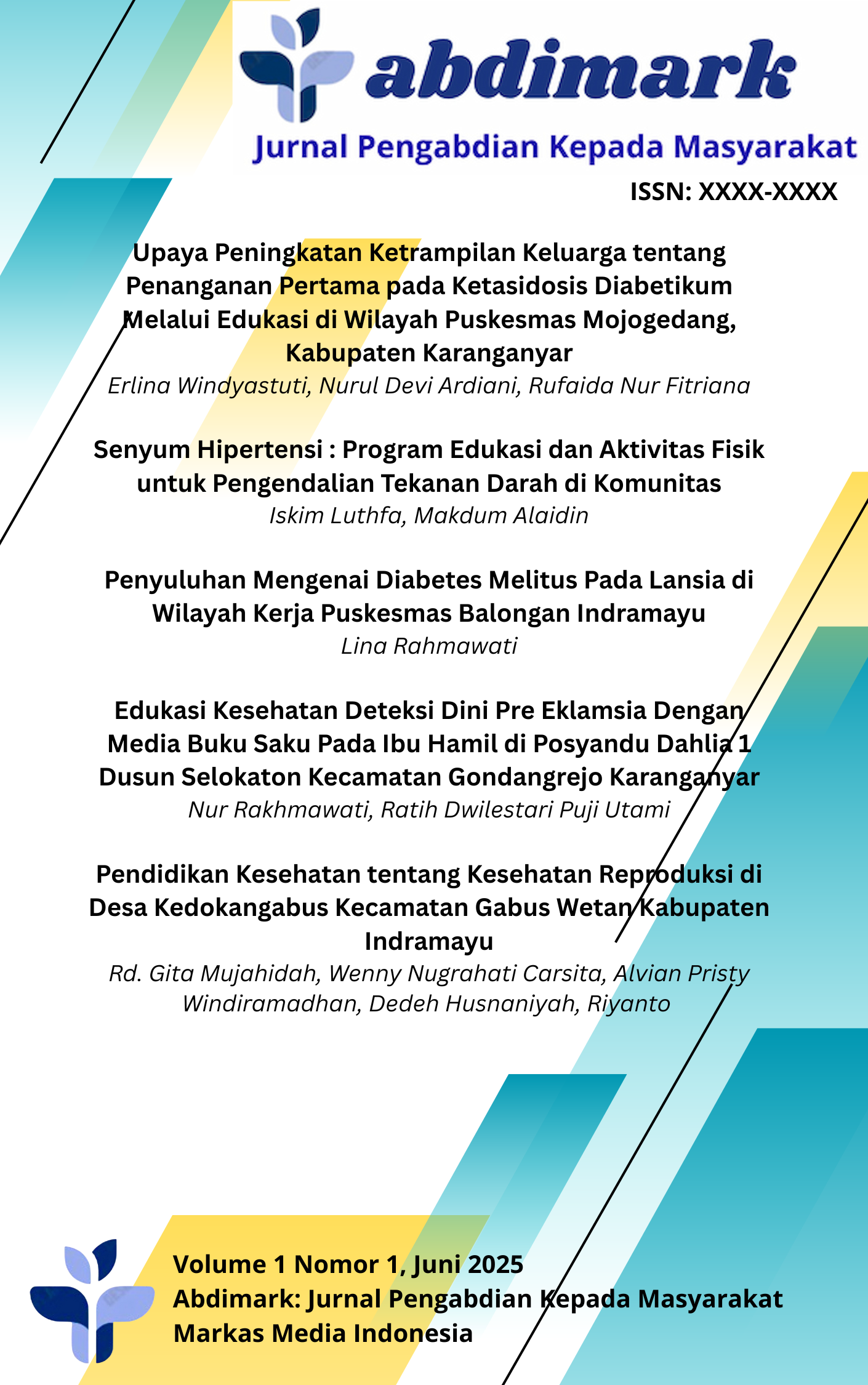Edukasi Kesehatan Deteksi Dini Pre Eklamsia Dengan Media Buku Saku Pada Ibu Hamil di Posyandu Dahlia 1 Dusun Selokaton Kecamatan Gondangrejo Karanganyar
Keywords:
preeclampsia, early detection, maternal health, pocketbook, community educationAbstract
Maternal mortality remains a critical public health challenge in Indonesia, with preeclampsia identified as one of the leading causes of maternal deaths, especially in rural areas. In Posyandu Dahlia 1, Selokaton Hamlet, Gondangrejo District, low antenatal care (ANC) attendance and lack of knowledge about preeclampsia prevention were observed among pregnant women. This community service aimed to improve early detection awareness and prevention practices related to preeclampsia through the use of an educational pocketbook and dzikir-based health promotion. The intervention was conducted in May–June 2024, involving 30 pregnant women, cadres, and local health stakeholders. Activities included lectures, simulations, and interactive discussions using pocketbook media as educational tools. Pre- and post-tests were administered to measure knowledge changes. Results showed that prior to the intervention, only 40% of participants were aware of preeclampsia and its preventive measures. After the program, 90% of participants demonstrated improved understanding and were able to explain early detection strategies. This indicates a significant increase in maternal health literacy and awareness of risk prevention. The program not only provided accessible health education but also fostered a more proactive attitude toward ANC visits and self-care during pregnancy. In conclusion, integrating religious practices such as dzikir with structured health education can be an effective strategy to promote early detection and prevention of preeclampsia in underserved communities.
Downloads
References
Anshori, S. (2018). Dzikir dan pengaruhnya terhadap perilaku. Jurnal Ilmu Dakwah, 38(2), 215–226.
Aryastami, N. K., & Tarigan, I. (2012). Meningkatkan kualitas pelayanan ANC di Indonesia. Buletin Penelitian Sistem Kesehatan, 15(4), 369–375.
Astuti, A. (2015). Preeklamsia dan risiko kematian ibu. Jurnal Kebidanan, 3(2), 12–18.
Fatkhiyah, N., Kodijah, K., & Masturoh, M. (2018). Determinan maternal kejadian preeklampsia: Studi kasus di Kabupaten Tegal, Jawa Tengah. Jurnal Keperawatan Soedirman, 11(1), 53–61.
Funnell, M. M., & Anderson, R. M. (2014). Empowerment and self-management of diabetes. Clinical Diabetes, 22(3), 123–127. https://doi.org/10.2337/diaclin.22.3.123
Ira, H., Sabilu, Y. D., & Rasma, M. (2017). Pengetahuan ibu hamil dan kunjungan ANC. Jurnal Kesehatan Reproduksi, 8(2), 105–112.
Johariyah, A., & Mariati, T. (2018). Efektivitas penyuluhan kesehatan dengan modul terhadap perubahan pengetahuan remaja. Jurnal Manajemen Kesehatan Yayasan RS Dr. Soetomo, 4(1), 38–46. https://doi.org/10.29241/jmk.v4i1.202
Kementerian Kesehatan Republik Indonesia. (2018). Profil Kesehatan Indonesia Tahun 2017. Jakarta: Kemenkes RI.
Maryani, K., Jati, S. P., & Purnamih, C. T. (2017). Faktor yang berpengaruh terhadap kepatuhan ibu hamil preeklamsia dalam pemanfaatan layanan ANC. Unnes Journal of Public Health, 6(4), 275–283.
Nursal, D. G. A., Tamela, P., & Fitrayeni. (2015). Faktor risiko kejadian preeklampsia pada ibu hamil di RSUP Dr. M. Djamil Padang. Jurnal Kesehatan Masyarakat Andalas, 9(2), 68–74. https://doi.org/10.25077/jkma.9.2.68–74.2015
Situmorang, T. H., Damantalm, Y., Januarista, A., & Sukri. (2016). Faktor-faktor yang berhubungan dengan kejadian preeklampsia pada ibu hamil di Poli KIA RSU Anutapura Palu. Jurnal Kesehatan Tadulako, 2(1), 1–75. http://jurnal.untad.ac.id/jurnal/index.php/HealthyTadulako/article/view/5744
Smith, S. M., Paul, G., Kelly, A., Whitford, D. L., O’Shea, E., & O’Dowd, T. (2011). Peer support for patients with type 2 diabetes: Cluster randomised controlled trial. BMJ, 342, d715. https://doi.org/10.1136/bmj.d715
World Health Organization. (2020). Maternal mortality. https://www.who.int/news-room/fact-sheets/detail/maternal-mortality


